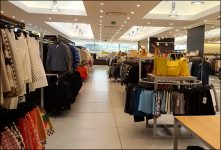
High-end clothing factory outlet stores trial RTLS system for inventory management
[ad_1]
Diffusione Tessile (DITE), the factory direct sales division of the fashion retailer Max Mara Group, uses an RFID real-time location system (RTLS) to reduce queues at the counter and ensure that customers can find what they are looking for. The system is installed in the company’s Pomezia store and is provided by ID Solutions SRL (a subsidiary of the RFID laboratory of the University of Parma). The solution uses 13 EPC Gen2 UHF RFID readers, which are connected to the 254 antenna through a multiplexer. After reading the data, ID Solutions’ RFID middleware forwards the data to a Web application for store employees to access.
The system is part of the EU-funded project based on RFID sensing applications, Real World Perception Management Information System (SERAMIS). In the past two years, SERAMIS has been promoting the use of the Italian RFID system, and DITE is a member of the project.

(Diffusione Tessile factory outlets installed 253 Laird far-field circularly polarized UHF reader antennas on its ceiling)
Although many retailers use passive UHF
RFIDTags track goods in and out of key locations through portal readers, but it is not so common to use RTLS solutions to track goods in stores. Retailers using RFID technology can understand the time of receipt of goods and the time of purchase based on the tag reading, while inventory counting still requires employees to walk around the store with a reader in hand.
Antonio Rizzi, a professor of industrial logistics and supply chain management at the University of Parma, said that the RTLS solution used by Diffusione Tessile is the result of a detailed investigation by the RFID laboratory of the University of Parma. The Diffusione Tessile situation is very unique and is a good test case for RTLS technology. The store has an area of 20,000 square feet, with 15,000 items in the store, and more than 40,000 items in the back room. Hundreds of consumers shop in the store every day, and it is open for 12 hours a day. Due to the large number of products, consumers often spend a lot of time finding the products they need. Retailers estimate that before the use of RFID technology, about 10% of sales are lost due to this.
In addition, there is a sales counter in the store to answer customer requests. The counter usually has a long line to ask if there are any available sizes and colors or the location of the items. In many cases, the staff at the counter need to enter the back room to manually search for the items needed by the user. During this period, the queue will get longer and longer, and consumers may leave the store as a result.
Stores can also use handheld readers for inventory counting. Due to the huge store area, manual inventory counting takes 2 working hours to complete.
In order to improve inventory accuracy, DITE began to trial UHF RFID technology in 4 stores and distribution centers in 2014, and tracked the products marked by tags through RFID portals and handheld readers. The system also uses an Impinj reader to read tags in the back room and a Zebra MC3190-Z handheld reader for regular inventory counting.
In 2015, the company began planning to test and deploy RTLS technology in Pomezia stores to provide real-time visibility of goods.

(An Impinj RFID reader is built into the trash bin at the cashier of the store to read the removed tags and track the removed items)
The Pomezia store is divided into 29 reading areas. The antenna that reads the tag can use software to identify the tag of an item in a specific area.
The system uses the Received Signal Strength Indicator (RSSI) and the tag reading rate to confirm the location of the tag in a specific area. The tag with the higher the reading rate of a given antenna, the closer to the antenna location. Then, ID Solutions’ middleware will analyze the data to determine the location.
Employees at the distribution center attach Smartrac Web Ucode 7 tags to clothing. The Pomezia store also installed 13 Impinj Speedway Revolution R440 4-port readers on the ceiling, which were connected to the 253 and Laird far-field circularly polarized UHF readers through a multiplexer. Thanks to the use of large-scale readers and antennas, the store can read all marked items every half an hour. Rizzi said: “This method can improve inventory accuracy.”
ID Solutions’ RFID system management software will determine the location of the tag and its area after collecting the read data. Each product tag ID will be bound to specific product details (such as clothing style, size and color).
The software comes with a web user interface, and store employees can log in to view product-related information. Back room employees can log in to determine whether they need replenishment.
In addition, the store also has an Impinj RFID reader built into the trash bin at the checkout counter. When the clerk throws the removed tag into the trash can, the reader can read the tag ID. The system knows the information of the goods that have been paid and adds it to the replenishment list.
Test results show that the inventory accuracy of the system can reach 98.25%, and the position accuracy can reach 99.4%.
Currently, the management of Diffusione Tessile is still evaluating whether to try the RTLS solution in all 25 stores. The company hopes to find that the system can increase sales by providing visualization and location information.
[ad_2]




